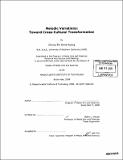Melodic variations : toward cross-cultural transformation
Author(s)
Huang, Cheng-Zhi Anna
DownloadFull printable version (18.34Mb)
Other Contributors
Massachusetts Institute of Technology. Dept. of Architecture. Program in Media Arts and Sciences.
Advisor
Barry L. Vercoe.
Terms of use
Metadata
Show full item recordAbstract
We all share similar innate emotions, but our cultural experiences nurture us to express them differently. The musical form "theme and variations" offer us a unique lens to uncover in each culture the relationships between the musical surface that touches us most directly, and the underlying structures that are more abstract. Variations are musical surfaces composed to explore the expressive potentials of the theme by transforming it along certain musical dimensions, while the theme itself can be seen as an intermediate pathway to the more abstract structures of a style. I approach cross-cultural transformation in music as a kind of cross-cultural variation, as the theme and variations tradition offers us a framework to explicitly consider which musical elements to stay fixed and which to vary. I propose to treat cross-cultural variation as a four-step process. First, the process of "melodic reduction" reduces the melodic surface of a theme to its underlying melodic progression. Second, "forward cross-cultural transformation" maps the uncovered progressions to those idiomatic in the cultural style that carries the variation. These cross-cultural mappings are approached by considering which of the melodic properties in the underlying progressions to preserve and which to transform. These properties include contour, scale-degree function, melodic formulae and tension. Third, "melodic elaboration" retrieves the melodic surfaces that possess the mapped melodic progressions. Fourth, "backward cross-cultural transformation" adjusts the melodic surface of the variation to strengthen its resemblance to the theme. My experimentation begins with the melodic variations on two historically related instruments, the Chinese zither, gu-zheng, and the Japanese zither, koto. Even though their repertoires evolved culturally to render very different melodic surfaces, it has been pointed out by ethnomusicologist Alan Thrasher that there is a high degree of similarity between their underlying structures. This enables a cross-cultural mapping at the structural level that ties together stylistically different melodic surfaces to exhibit a kind of crosscultural variation. I will conclude by briefly discussing the effectiveness of variation as an approach to cross-cultural transformation.
Description
Thesis (S.M.)--Massachusetts Institute of Technology, School of Architecture and Planning, Program in Media Arts and Sciences, 2008. Includes bibliographical references (p. 99-101).
Date issued
2008Department
Program in Media Arts and Sciences (Massachusetts Institute of Technology)Publisher
Massachusetts Institute of Technology
Keywords
Architecture. Program in Media Arts and Sciences.